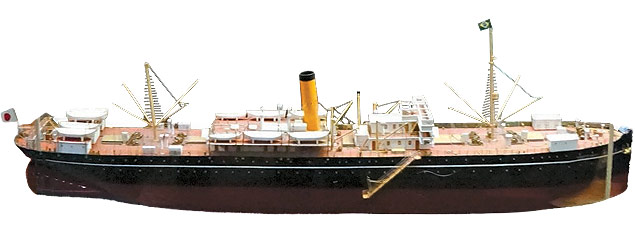Latest Photo Galleries
Brazilian Markets
17h34 Bovespa |
-0,32% | 124.741 |
16h43 Gold |
0,00% | 117 |
17h00 Dollar |
+0,38% | 5,1487 |
16h30 Euro |
+0,49% | 2,65250 |
ADVERTISING
Ship that Brought Japanese to Brazil to be Rescued by Russian Expedition
02/29/2016 - 08h13
Advertising
JULIANA COISSI
FROM CURITIBA
It was born English, purchased by the Russians and taken over by the Japanese. It experienced two wars before it ended up at the bottom of the sea. Before, it served as a hospital and factory. It transported charcoal, soldiers, sardines. For Brazilians, its greatest role was bringing the first 781 Japanese immigrants to the country, long ago in 1908.
The history of the Kasato Maru ship, symbol of the beginning of the Japanese community in Brazil, is on the verge of being rescued. Literally.
| Museu Histórico da Imigração Japonesa | ||
 |
||
| Finding the Kasato Maru's anchor is an old dream of the Nipponese community |
By way of a request from Brazilians made through the Russian Embassy in Brasília, members of the Russian Geographical Society, a research institution in the country, are expected to explore the icy waters near the Bering strait, where the ship sank, in 1945, to remove its pieces and bring them to the country.
It is difficult to say which items have been preserved after 71 years in ocean waters, but those involved in the project aim to recover anchors, rudder and utensils such as metals and dishware.
The collection of discovered items will be displayed in Moscow and other Russian cities and should arrive in the port of Paranaguá, in the Brazilian state of Paraná, in 2017.
The Russian Geographical Society and ITAPAR (Technological and Environmental Institute of Paraná)-the body that will be responsible for the storage of the material, signed off on the terms for scientific cooperation to make the contract possible.
According to ITAPAR's president Acef Said, the final destination of the pieces will be defined with the Japanese community in Brazil, but some will definitely be sent to São Paulo and Curitiba, the states that received the greatest number of immigrants.
Dream
Finding the Kasato Maru's anchor is an old dream of the Nipponese community, Said explained. In 2005, with the approaching 100th anniversary of the immigration, federal deputies who were descendants sought help from Russia, where the ship sank. The negotiations, however, did not make progress at the time.
In 2011, a new effort arose to make the idea a reality. According to Said, who was the middleman for the rescue, it was the Russian ambassador Serguey Akopov who found the solution.
The alternative was to look beyond the historical aspect and transform the project into a scientific expedition that would use the opportunity to study, for example, marine biology and the effects of global warming.
With this research angle, it became possible for the Russian Geographical Society to take over the expedition, an entity that has President Vladimir Putin as member, in addition to ships and dive teams accustomed to that type of research.
The aim is to involve researchers from both countries. According to the embassy's first secretary, Yuriy Mozgovjy, the costs of the expedition have yet to be determined.
"It was a decision [Rússia's], for humanitarian and cultural reasons,to support a part of the Brazilian population, the one that made that request and to realize that dream. Why not?" Mozgovoy said.
The Russian's gesture has pleased Brazilian and Japanese residents alike.
"It is a really symbolic ship for our immigrants because it was the first. Several came after, but it was the pioneer", said consul Jiro Takamoto, with the Consulate of Japan in São Paulo.
The diplomatic body estimates that there are 1 million Japanese descendants in the country.
From beginning to end
Through historical coincidence, Russia, once again, will be the key player in the Kasato Maru's trajectory. That's because it was the Russians who purchased the ship, sank it twice and, now, are coming to its rescue.
Acquired in 1900 from a shipyard in Newcastle, in the United Kingdom, the ship born "Potosi" was rebaptized "Kazan". Five years later, in a battle with the Japanese, the Russians, defeated, decided they were not going to leave the ship there for the enemy and sank it before fleeing.
Japan, however, rescued and fixed the ship. Afterwards, the ship was incorporated into the imperial navy.
In June of 1908, the Kasato Maru arrived in the port of Santos (SP) with the first Japanese families contracted to work in agriculture, as part of an agreement between the two governments.
In 1945, during World War II, the ship sank after being bombed by Russian planes near the Kamchatka peninsula.
Translated by SUGHEY RAMIREZ
Read the article in the original language



